Clematis are showy, versatile vines that are well-known and beloved for their beautiful flowers.
They’re outstanding for adding vertical accents with bright, bold colors climbing to the sky.
But they’re also highly adept in containers, as ground covers or specimens, and to add secondary color weaving through deciduous trees and shrubs.
There’s a large and wonderful selection of flower colors, shapes, and sizes with new cultivars added each year.
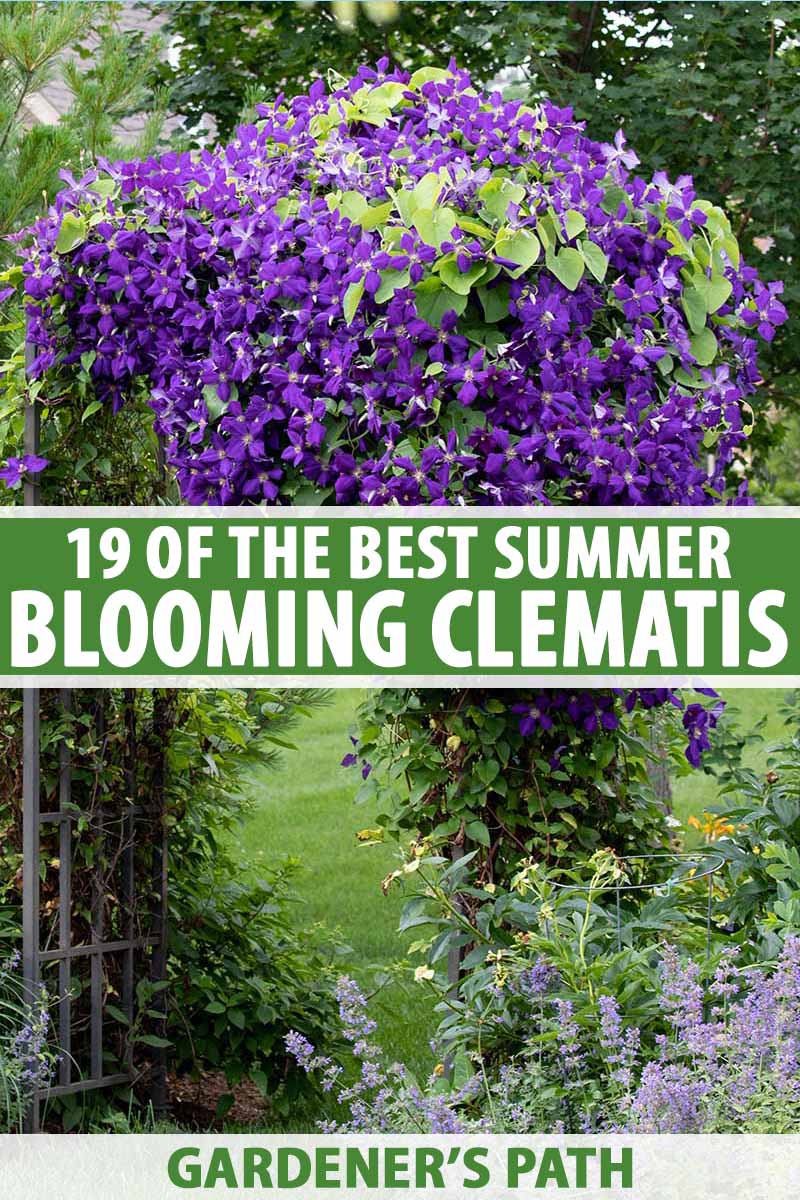
We link to vendors to help you find relevant products. If you buy from one of our links, we may earn a commission.
And you can enjoy them almost year-round if you choose a selection from each of the three different flowering times – those that bloom in late winter/early spring, mid to late spring, and summer into fall.
The summer bloomers are the ones that typically flower from June through September, or even into October.
And while they aren’t quite as popular as the big-blossomed mid-spring types, there are plenty of enticing varieties available to produce masses of colorful flowers throughout the hot months.
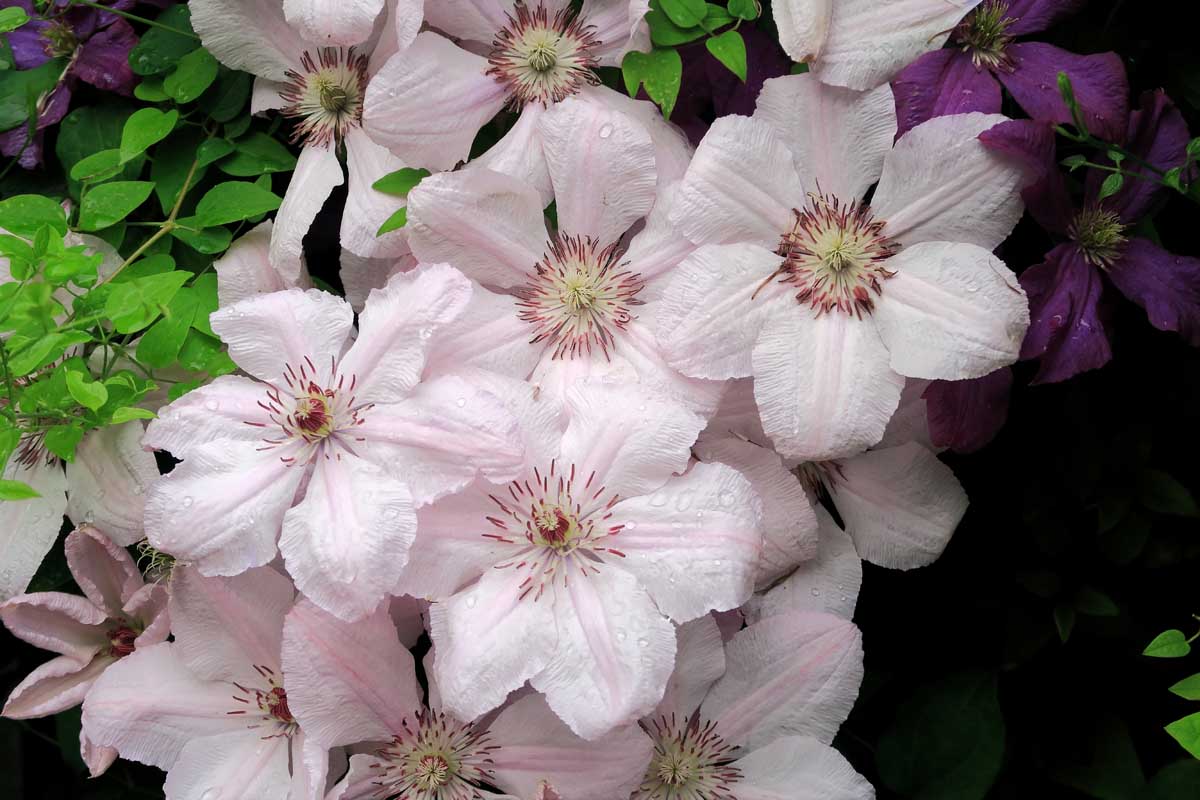
These summer varieties mostly belong to pruning Group 3 (aka Group C), which are the easiest to prune. You can find Group 3 pruning info in our growing guide.
They’re also divided into two growth habit groups – vining and non-vining, or herbaceous types.
Vining types provide outstanding vertical growth and require support in the form of arbors, arches, fences, pergolas, pillars, and trellises.
They can also be grown through shrubs like rhododendrons, climbing roses, deciduous trees, and other woody types of clematis such as the early blooming C. montana.
The herbaceous, non-vining ones don’t climb because they lack twining petioles. Instead, they have a compact, bushy form with upright, lateral growth.

These are the low-growing drapers and spillers, known for their colorful sprawl.
This growth habit makes them superb in containers as a specimen, or as a ground cover, in perennial beds, and to spread over low areas like banks, rocky ground, or stumps.
Many are free flowering, which means they bloom profusely over a long period, from midsummer to fall.
Now, here’s our lineup of 19 of the best summer flowering clematis for your garden:
19 of the Best Summer Blooming Clematis
Herbaceous, Non-Vining
Here are a selection of my favorite herbaceous clematis varieties:
1. Arabella
One of the most popular non-vining varieties, ‘Arabella’ bears six-sepaled star-shaped flowers of deep amethyst that start out with a reddish tint.
The three- to four-inch flowers have cream white stamens and bloom over an exceptionally long season, from early summer to early fall, with blooms followed by ornate, plumed seed heads.
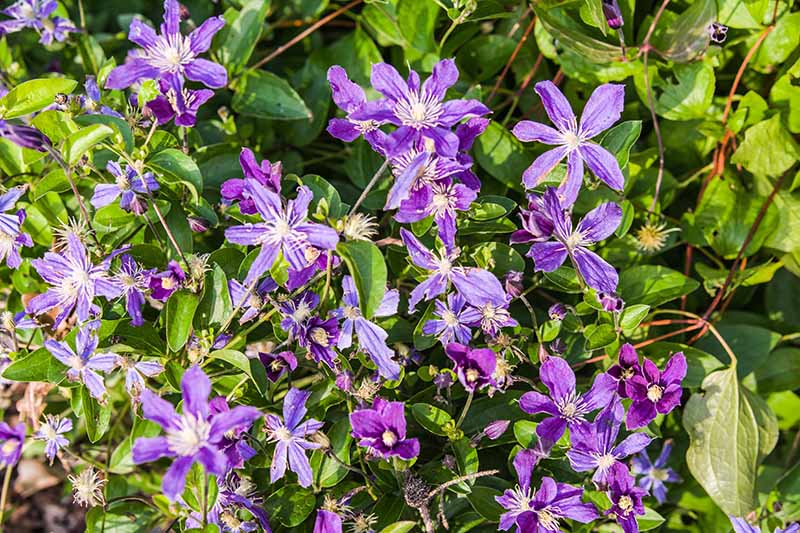
A non-climber, it prefers a full sun location. Its upright growth looks magnificent as a ground cover or container specimen, or weaving through shrubs and deciduous trees.
Hardy in Zones 4 to 10, it quickly grows three to five feet in length. Prune in late winter or early spring, cutting back to a set of strong buds about eight inches above the ground.
You can find ‘Arabella’ plants in two-and-a-half-inch pots available from Hirt’s Gardens via Walmart.
2. Mrs. Robert Brydon
Masses of small, half-inch flowers with lavender sepals and prominent platinum stamens form the sparkling clusters that ‘Mrs. Robert Brydon’ is known for.
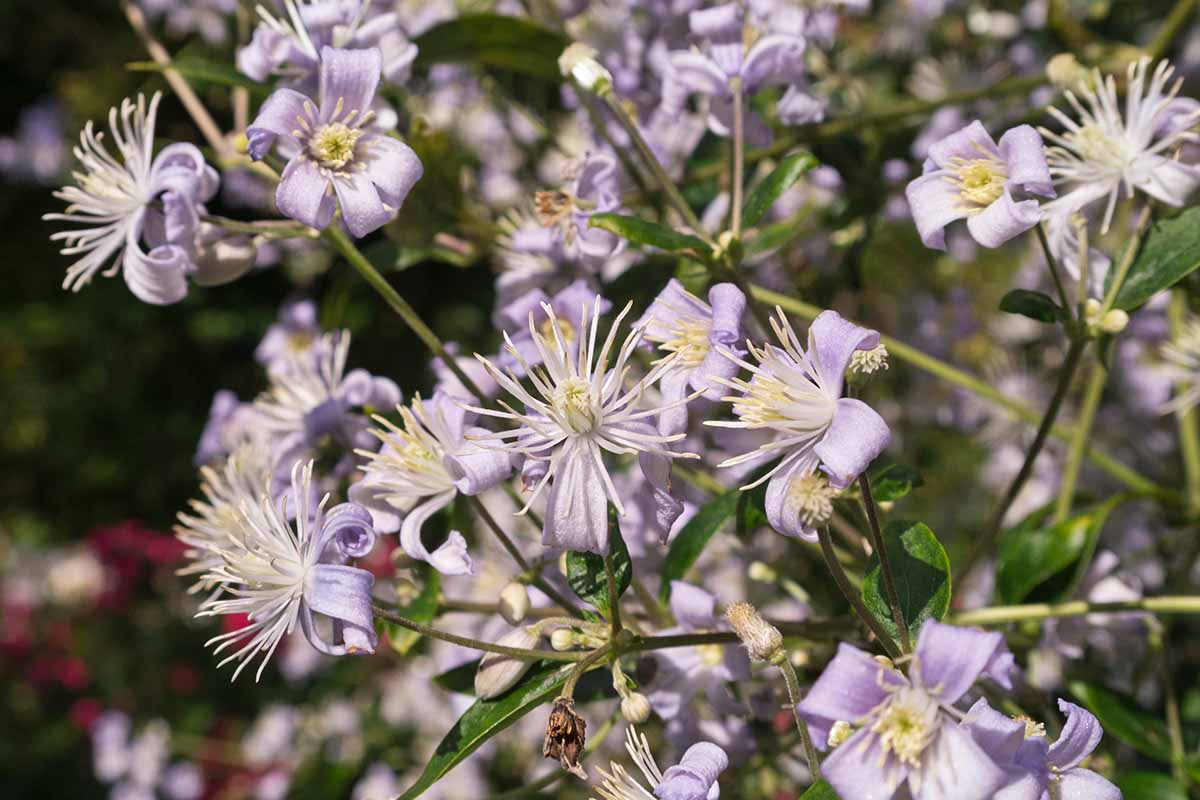
Blooming from mid- to late summer amid dark green foliage, the flowers are followed by silky seed heads.
The vigorous upright growth can be tied to a trellis for vertical interest. Or you can give it free rein to sprawl and tumble through shrubbery or spread as a lofty, eye-catching groundcover.
Hardy in Zones 4 to 9, it grows six to eight feet in full to partial sun and can be pruned back to three inches in early spring.
3. Sapphire Indigo
Masses of four- to five-inch, sapphire blue flowers form a striking and nearly continuous blooming habit from June to September.
After flowering, the vines are covered with decorative, silky seed heads.
Fast growing, it can be tied up on supports or left to spread as a showy, dense groundcover – and it makes a sumptuous spiller in containers and hanging baskets.
Hardy in Zones 4 to 10, it prefers full to partial sun and grows only four to six feet. It flowers entirely on new wood and should be pruned back to six inches in late winter or early spring.
Plants in #1 containers are available from Nature Hills Nursery.
4. Solitary
Non-vining and multi-stemmed with a mounding habit, ‘Solitary’ features dainty, cornflower blue to violet blooms with creamy stamens.
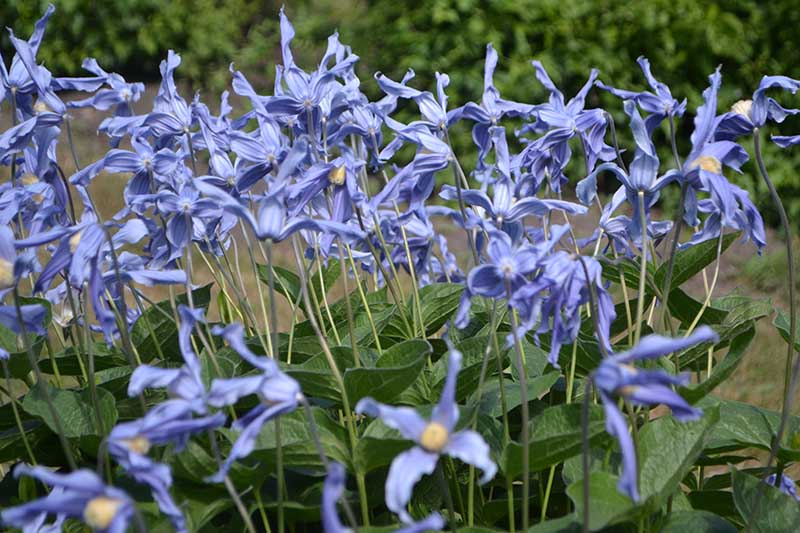
The nodding, two- to three-inch urn-shaped flowers have twisted sepals and an exceptionally long bloom time of mid-May to September.
Flowers are followed by silky, tufted seed heads throughout autumn.
Planted in full or part sun, it’s a natural for scrambling and sprawling over the landscape. It can also be staked or tied to supports, left to weave through shrubs, or used as a spiller in large containers.
And the long-stemmed flowers are excellent for cutting as well!
This cultivar grows three to five feet and is hardy in Zones 3 to 7. Prune in early spring to shape only.
You can find plants in two-and-a-half-inch containers available from Hirt’s Gardens via Walmart.
Vining
For a glorious display of summer blooms on a trellis or over an arbor, the vining types are an ideal choice.
5. Aotearoa
An abundance of purple, three- to five-inch star-shaped flowers with contrasting yellow stamens bloom from mid-summer to early fall.
Elegant sepals are slightly recurved at the tips, giving them a graceful, whimsical appearance. Light green leaves are tinged with red around the edges.
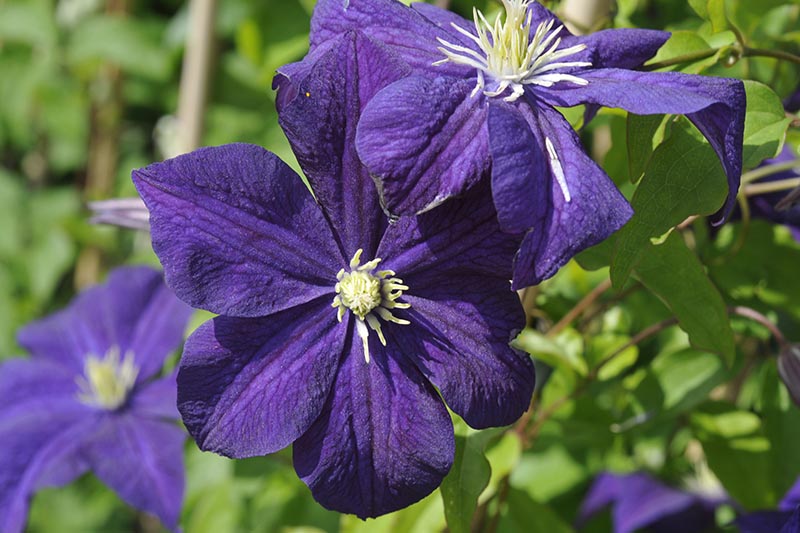
These lovely flowers thrive just as well in shady locations as they do in full sun. This is a wonderful performer when growing over arbors, fences, and with climbing roses.
Aotearoa is the Te Reo Maori word for New Zealand, which translates to “the land of the long white cloud.”
‘Aotearoa’ grows nine to 12 feet long and can be pruned to a strong set of buds about 12 inches above the ground in early spring. This cultivar is hardy in Zones 3 to 11.
6. Avant Garde
A large flowering hybrid, ‘Avant Garde’ has stunning, two-inch double flowers of deep, velvety magenta with a center consisting of dahlia-like sepals in flamingo pink.
Bred from disease resistant species, this vigorous plant produces an abundance of flowers.
A robust but well-behaved climber, the two-tone flowers pop among the deep green leaves.
It loves to climb with its head in the sun, and really shines when scrambling over supports such as arbors, fences, and pergolas.
Hardy in Zones 4 to 9, it needs a full sun location. Cut it back hard in early spring to six to 12 inches, above pairs of healthy buds.
Container plants are available at Nature Hills Nursery.
7. Ernest Markham
With large, velvety flowers of raspberry red and contrasting creamy filaments tipped with chocolate anthers, ‘Ernest Markham’ makes a striking vertical display.
The four- to six-inch blooms are free flowering from midsummer to fall.
It makes a handsome specimen in containers, flowerbeds in cottage and courtyard gardens, or climbing up trellises and through shrubs.
It grows 10 to 12 feet and requires a full to part-sun location.
Hardy in Zones 4 to 8, it can be pruned in late winter or early spring. Cut just above a set of strong leaf buds, eight to 18 inches above the ground.
Plants in one-gallon pots are available at Burpee.
8. Golden Tiara
This vigorous climber in sunshine yellow has a pleasant fragrance and puts on a long lasting, showy display from early June through September.
The two- to four-inch nodding, lantern-like flowers provide spectacular contrast from the magenta anthers and are followed by large, fluffy seed heads that birds like to use as nesting materials.

With a strong twining habit, it loves to climb up arbors and trellises or through shrubs, making a striking summer screen.
Growing 10 to 15 feet, it likes a full sun location and is hardy in Zones 3 to 9. Cut vines back hard in early spring to 10 to 18 inches, just above a strong set of buds.
9. Hagley Hybrid
A compact vine, ‘Hagley Hybrid’ features a profuse display of showy, eight-sepaled flowers in chiffon pink from May through September.
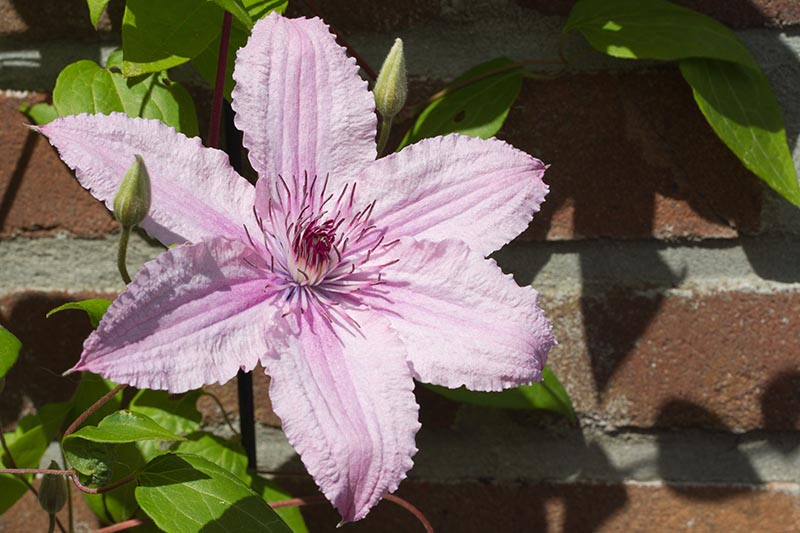
The large, six- to eight-inch flowers have an opalescent shine that is beautifully highlighted by the dark ruby anthers.
This free flowering vine prefers partial shade, and is an ideal choice to brighten up dark corners on the deck or patio while twining up trellises or through hedges and shrubs.
And its tidy growth makes it a choice selection for containers.
Hardy in Zones 4 to 11, it grows seven to 10 feet. Prune hard in late winter or early spring to a set of healthy buds about 12 inches above the ground.
You can find plants in four-inch containers available from Wekiva Foliage via Walmart.
10. Happy Jack Purple
Large and velvety plum-colored flowers have a pretty yellow throat and anthers that give charming contrast. The three- to five-inch blooms are long lasting and appear from late June through September.
Highly ornamental with a tidy habit, it’s attractive as a back border planting, in containers, or clambering up supports like arbors and trellises.
Hardy in Zones 5 to 9, it likes a full to partial sun location and grows six to eight feet.
Prune vines back in early spring to one to to feet above the ground, leaving two sets of strong buds in place.
Plants in quart-sized containers are available at Home Depot.
11. Jackmanii
An old-fashioned favorite with large velvety flowers of royal purple with magenta ribs and creamy anthers.
Masses of five to seven-inch blooms appear from mid-June to September, and silky platinum or rosy colored seedheads add interest right through autumn.
This prolific vine provides spectacular vertical highlights in the garden. A good climber for arbors, fences, and trellises, it’s also striking as a ground cover or twining through shrubs.
This cultivar grows 10 to 12 feet, requires full sun, and is hardy in Zones 4 to 9. Prune hard in late winter or early spring to a pair of strong buds about 12 inches from the ground.
You can pick up container plants at Nature Hills Nursery.
12. Pink Fantasy
This compact vine is highly free flowering from July to September.
It features an abundance of four to six-inch blush pink blooms with raspberry bars and matching anthers that really pop against the rich, dark green foliage.
Ideal for small spaces, it makes an attractive specimen in containers, tumbling around rockeries, or weaving through shrubs.
Hardy in Zones 4 to 9, it enjoys a partial shade location. It can handle full sun, however the flowers may fade in intense light.
Prune hard in late winter or early spring to a set of healthy leaves about 12 inches above the ground.
Container plants are available at Burpee.
13. Pink Mink
‘Pink Mink’ produces large drifts of ruffled, candy pink flowers with bold fuchsia bars and yellow anthers that bloom from early June to early October.
A continuous bloomer, it makes an eye-catching specimen where it can climb freely on structures such as fences, pergolas, and trellises.
Hardy in Zones 4 to 9, it grows nine to 10 feet and prefers a full to partial sun location. Prune hard to about 18 inches in early spring, leaving a set of healthy buds on each vine.
You can find container plants available at Burpee.
14. Princess Diana
A small-flowering vine, ‘Princess Diana’ has distinctive tulip-shaped flowers of raspberry red with hot pink margins and delicate yellow anthers that bloom from June to September.
After flowering, the vines are adorned with flouncy platinum seed heads.
A profuse bloomer, this compact vine requires support for climbing and adds charm as a specimen in containers, as well as cottage and courtyard gardens.
It may also be grown as a groundcover.
It requires a full to partial sun location and grows six to eight feet. Hardy in Zones 4 to 8, it can be cut back to a pair of healthy buds around eight inches above the ground in early spring.
Pick up container plants at Nature Hills Nursery.
15. Ramona
Delightfully cool with sea green leaves, ‘Ramona’ has large, six-petaled lavender-blue flowers with a striking accent of deep, winey purple anthers.
The single flowers measure five to seven inches and bloom prolifically from May to September.

It can be grown in full or part sun and makes a superb choice to cover arbors, fences, pergolas, and walls. It also creates a pretty privacy screen on trellises or weaving through shrubs.
A moderate grower, it reaches eight to 12 feet and is hardy in Zones 4 to 8.
‘Ramona’ can be pruned according to recommendations for Group 2 or 3, but it flowers most proficiently when treated as a Group 3 cultivar.
Cut back to two sets of strong buds in late winter or early spring.
Plants in two-and-a-half-inch pots are available from Hirt’s Gardens via Walmart.
16. Rouge Cardinal
A showy vine that produces a profusion of four to six-inch blooms from June to September, ‘Rouge Cardinal’ features flowers of velvety cardinal red with gold filaments and mahogany anthers.
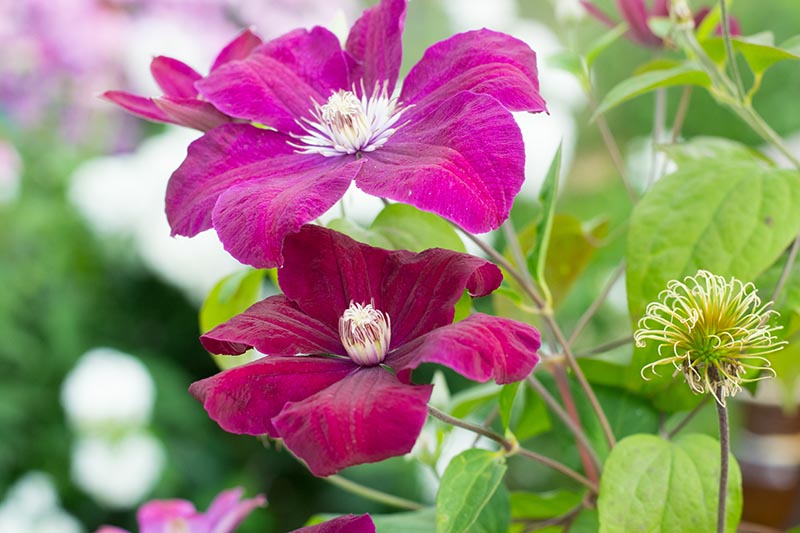
A dependable performer in full sun to part shade, it’s outstanding in containers, as a spiller, on trellises, or climbing through shrubbery.
Hardy in Zones 3 to 8, it grows up to 10 feet. Cut back to a set of healthy leaves about 12 inches above the ground in early spring.
Grab ‘Rouge Cardinal’ plants in four-inch pots available from Wekiva Foliage via Walmart.
17. Sweet Autumn
‘Sweet Autumn’ is a very vigorous grower with masses of small white cruciform flowers that seem to float on the glossy, dark green leaves.
The flowers are highly fragrant and bloom in August and September followed by attractive, plumed seed heads.
It does well in full sun and is also tolerant of light shade.
This fast-growing vine needs plenty of strong support to accommodate its growth and does well on large structures like fences, pergolas, and sheds.
It also makes a large, matted ground cover that effectively chokes out weeds.
Hardy in Zones 5 to 9, it grows 15 to 30 feet. Cut back to a set of strong buds 12 to 18 inches above the ground in early spring.
Plants in two-and-a-half-inch containers are available from Hirt’s Gardens via Walmart.
18. Sweet Summer Love
Truly a plant that delivers it all, ‘Sweet Summer Love’ has gorgeous cruciform flowers that range in color from cranberry and magenta to royal purple with long, cream colored stamens.
Long blooming, the flowers appear from early July to mid-September and have a lovely, sweet scent of almonds.
It does well in full to partial sun, and needs support from arbors, trellises, or other shrubs.
But be sure to grow it where you can enjoy the juicy colors and pretty fragrance – on pillars, posts, or trellises close to windows, and along patios, decks, and pathways.
A fast-growing climber, it reaches 10 to 15 feet and can be pruned hard in late winter or early spring – leave at least two sets of buds on each stem. This cultivar is hardy in Zones 4 to 9.
Container plants are available at Nature Hills Nursery.
19. Ville de Lyon
A large-flowering vine, ‘Ville de Lyon’ features a profusion of showy, four to six-inch cherry red flowers with cream and golden stamens.

The sepals have darker, carmine margins and a lovely opalescent sheen that seems to light them from within.
A good choice for long-lasting, sumptuous blooms, it adds flair as an accent, in containers, and climbing vertically on supports like trellises.
Or let it twine and weave through hedges and shrubs.
Hardy in Zones 4 to 8, it grows eight to 12 feet. Cut vines back hard in late winter or early spring to six to nine inches above a set of well-formed buds.
You can find ‘Ville de Lyon’ plants available at Nature Hills Nursery.
A Vine Like No Other
Now that you have a taste for these marvelous plants, will you be adding some to your garden?
Bright, beautiful, and wonderfully easy to care for, summer blooming clematis is a vine like no other.

Fast growing and hardy, you’ll love how versatile these are throughout the garden.
Try them as ground covers, specimen plants, vertical accents, or to add secondary color and added interest to shrubs and deciduous trees – they adapt to almost any setting!
For more information on caring for clematis flowers, be sure to add these to your reading list next:
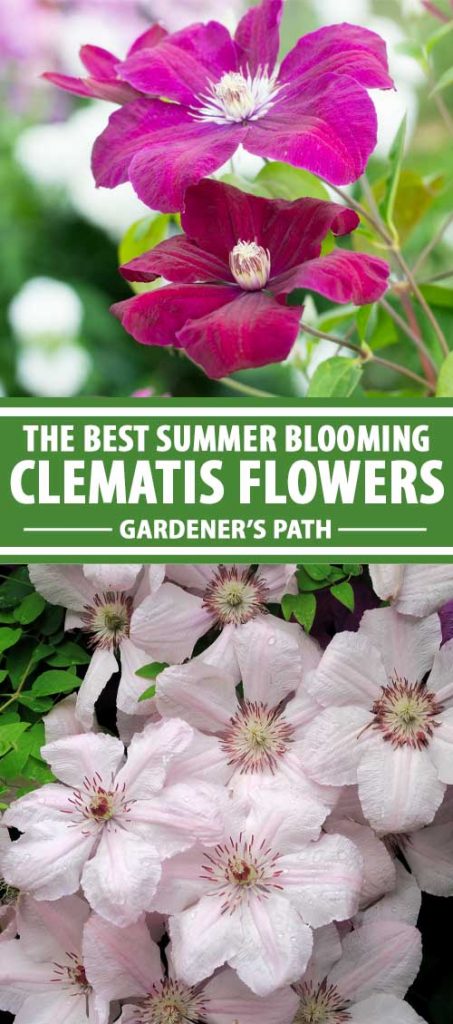
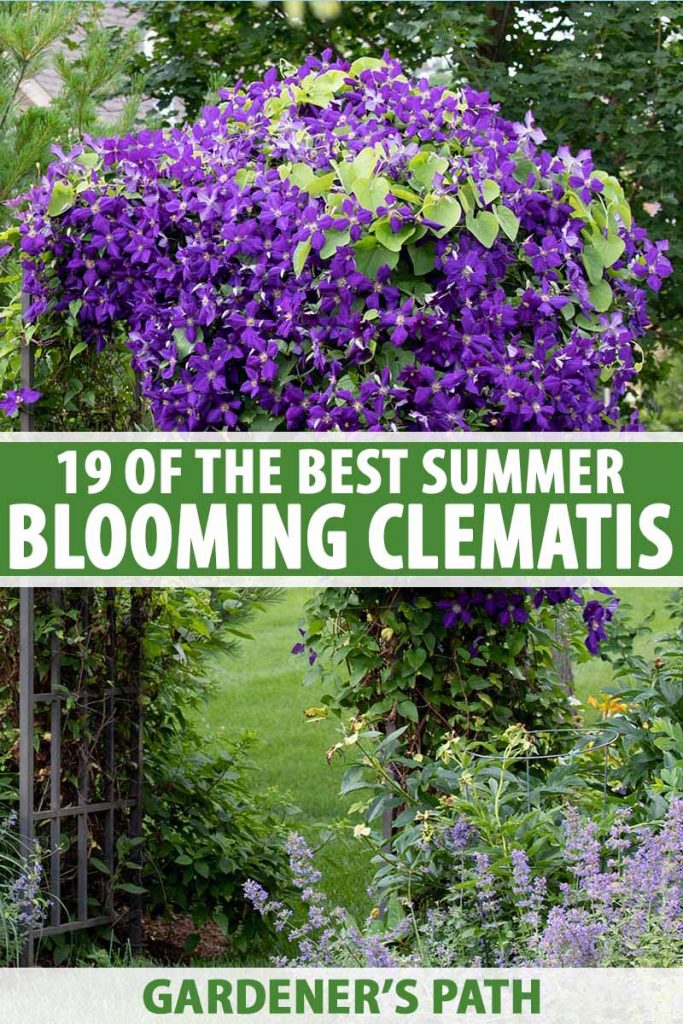
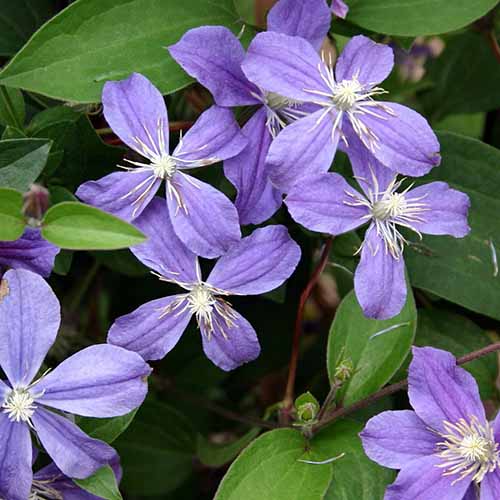
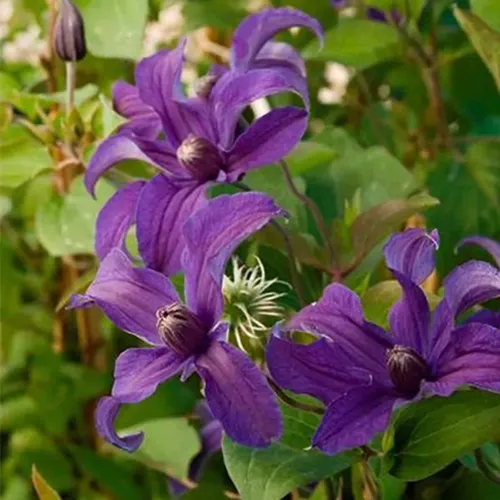
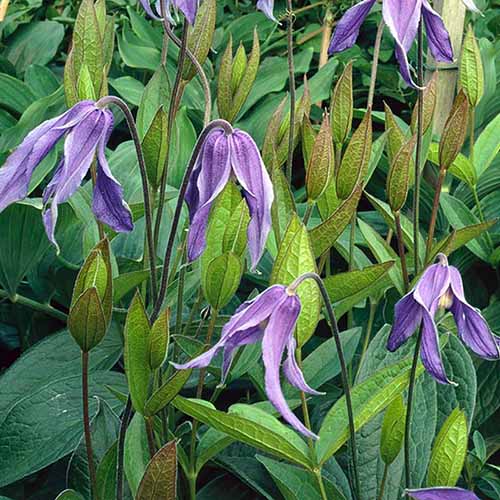
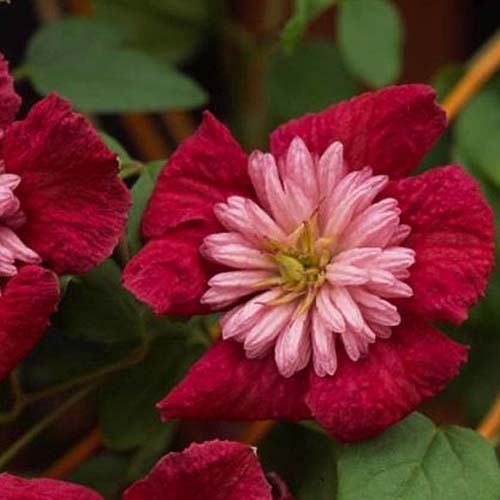
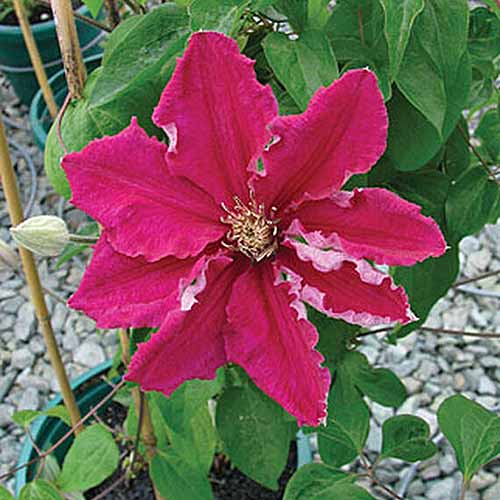


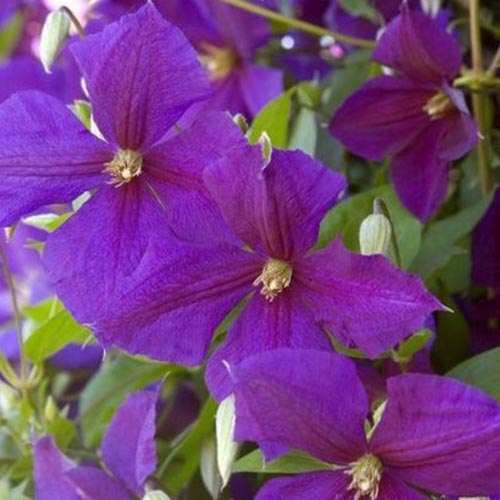

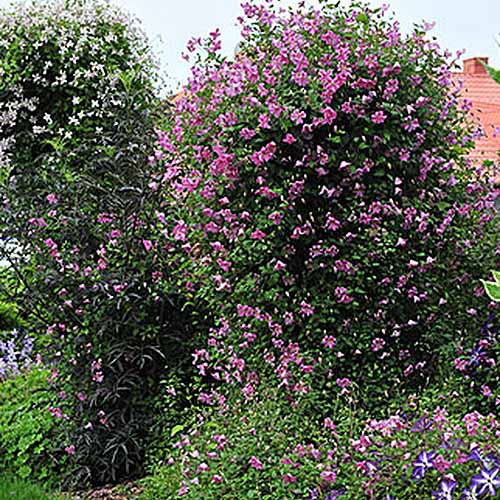

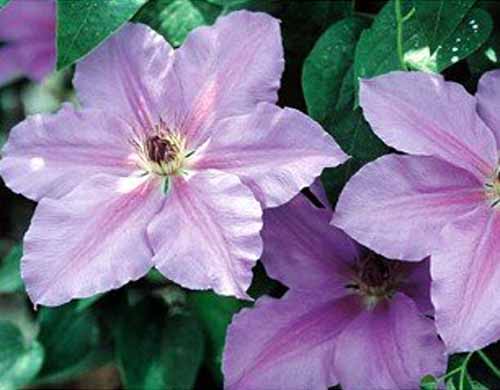
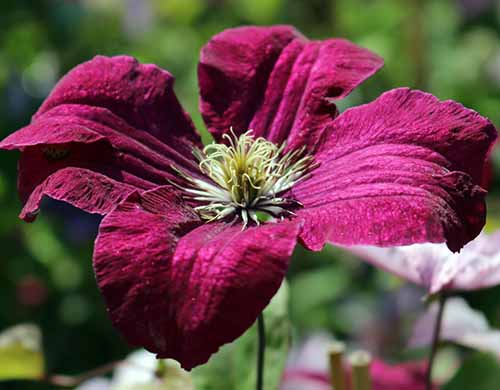

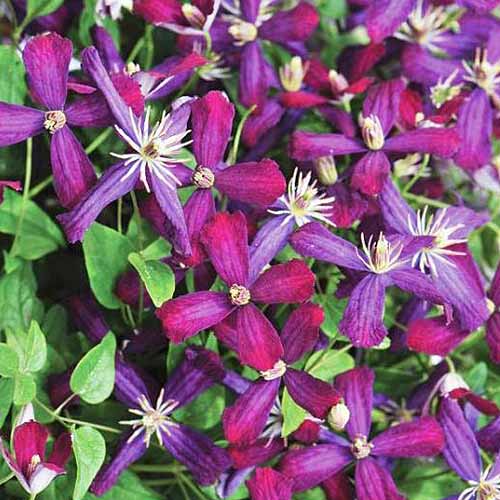
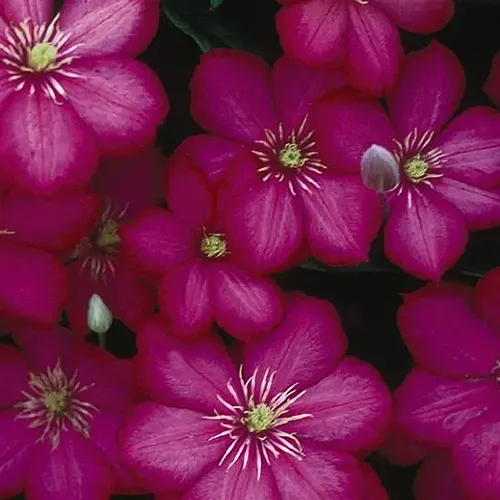
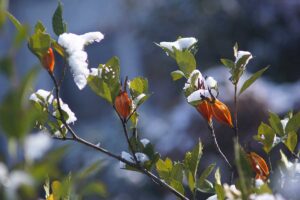


A very helpful selection and well-explained pruning information. Now I know why my Jackmani isn’t blooming the way it should.
Hi Lorna – finding these Clematis guides Really helpful and clearly written. I do have a question though regarding the variety in the last picture. I can take a couple of guesses but I’m not sure. What I’m really drawn to here is the shape the bloom takes before fully opening. It’s Lovely. Do you know which variety this is?
Hi Jo, yes the cultivar is called ‘Rhapsody’, a six-petaled variety in Group 2 that blooms on old and new growth – and retains its rich purple coloring even in hot sun!
Thanks for asking!
Wonderful, informative piece. Is there a benefit to cutting them back other than to keep them cleaned up or to make the plant stronger? Do I have to cut Clematis back each year? Some of these in the article surely weren’t grown in one season.
This was answered in a subsequent post. Love this site! I now know my Clematis is in group 1. Very helpful! I’ve never pruned mine, it’s spindly and doesn’t have a lot of blooms even after 7 years. I will wait until after flowering this spring and cut it back to 12” as your pruning post instructed. Thank you.
You’re very welcome Jackie!